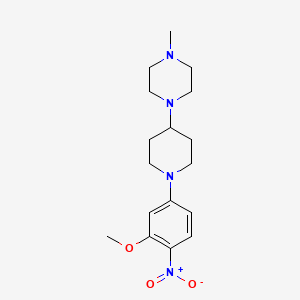
H-His-Gly-Glu-Gly-aThr-Phe-aThr-Ser-Asp-Val-Ser-Ser-Tyr-Leu-Glu-Gly-Gln-D-Ala-D-Ala-Lys-Glu-Phe-aIle-D-Ala-Trp-Leu-Val-Lys-Gly-Arg-NH2
Vue d'ensemble
Description
L'albiglutide est un agoniste du récepteur du peptide-1 de type glucagon utilisé dans le traitement du diabète de type 2. Il est commercialisé sous les noms de marque Eperzan en Europe et Tanzeum aux États-Unis. L'albiglutide est un analogue polypeptidique du peptide-1 de type glucagon humain produit par ADN recombinant, conçu pour améliorer la sécrétion d'insuline dépendante du glucose, supprimer la sécrétion inappropriée de glucagon, retarder la vidange gastrique et réduire l'apport alimentaire .
Mécanisme D'action
Target of Action
Albiglutide primarily targets the glucagon-like peptide-1 (GLP-1) receptor . This receptor plays a crucial role in glucose homeostasis, making it a key target in the management of type 2 diabetes .
Mode of Action
Albiglutide acts as an agonist at the GLP-1 receptor . This interaction stimulates the receptor, leading to an increase in insulin secretion, predominantly in the presence of high blood glucose . Additionally, albiglutide slows down gastric emptying, further aiding in the control of blood glucose levels .
Biochemical Pathways
The activation of the GLP-1 receptor by albiglutide leads to an increase in glucose-dependent insulin secretion . This helps to regulate blood glucose levels and is particularly beneficial in the context of type 2 diabetes, where insulin production or sensitivity is often impaired . Furthermore, the slowing of gastric emptying can reduce the rate at which glucose enters the bloodstream, providing additional control over blood glucose levels .
Pharmacokinetics
Following subcutaneous injection, albiglutide reaches maximum blood concentrations after 3 to 5 days . Steady-state concentrations are achieved after three to five weeks . The substance is most likely broken down by protease enzymes to small peptides and amino acids . The elimination half-life of albiglutide is approximately 5 days , which may allow for once-weekly or less frequent
Analyse Biochimique
Biochemical Properties
Albiglutide acts as an agonist at the GLP-1 receptor, which makes it a type of incretin mimetic . This causes an increase in insulin secretion, predominantly in the presence of high blood glucose, and also slows down gastric emptying .
Cellular Effects
Albiglutide has a significant impact on various types of cells and cellular processes. It influences cell function by increasing insulin secretion, predominantly in the presence of high blood glucose . This can have a profound effect on cell signaling pathways, gene expression, and cellular metabolism.
Molecular Mechanism
The molecular mechanism of action of Albiglutide involves its role as an agonist of the GLP-1 receptor . This interaction leads to an increase in insulin secretion, predominantly in the presence of high blood glucose. It also slows down gastric emptying, which can have a significant impact on the body’s metabolic processes .
Temporal Effects in Laboratory Settings
It is known that Albiglutide has a half-life of 5 (4–7) days , indicating its stability and potential for long-term effects on cellular function.
Metabolic Pathways
Albiglutide is involved in the incretin metabolic pathway, where it acts as an agonist of the GLP-1 receptor . This interaction leads to an increase in insulin secretion, predominantly in the presence of high blood glucose, and also slows down gastric emptying .
Méthodes De Préparation
Voies de synthèse et conditions de réaction : L'albiglutide est synthétisé à l'aide de la technologie de l'ADN recombinant. Le processus implique l'insertion du gène codant pour le polypeptide albiglutide dans un vecteur d'expression approprié, qui est ensuite introduit dans une cellule hôte, généralement Escherichia coli ou une levure. Les cellules hôtes sont cultivées dans des conditions spécifiques pour exprimer le polypeptide albiglutide, qui est ensuite purifié par une série de techniques chromatographiques .
Méthodes de production industrielle : La production industrielle d'albiglutide suit une approche similaire de l'ADN recombinant, mais à plus grande échelle. Le processus de production comprend la fermentation, la lyse cellulaire, l'extraction des protéines et la purification. Le produit final est formulé en injection sous-cutanée pour une utilisation clinique .
Analyse Des Réactions Chimiques
Types de réactions : L'albiglutide subit principalement une dégradation protéolytique dans l'organisme. Il ne participe pas aux réactions chimiques typiques telles que l'oxydation, la réduction ou la substitution en raison de sa nature peptidique .
Réactifs et conditions courants : La dégradation de l'albiglutide implique un clivage enzymatique par des protéases. Les conditions spécifiques de ces réactions sont physiologiques, se produisant dans le corps humain .
Principaux produits formés : Les principaux produits formés à partir de la dégradation de l'albiglutide sont des fragments peptidiques plus petits et des acides aminés, qui sont ensuite métabolisés ou excrétés .
4. Applications de la recherche scientifique
L'albiglutide a plusieurs applications en recherche scientifique, en particulier dans les domaines de la médecine et de la pharmacologie :
Médecine : L'albiglutide est utilisé pour gérer les niveaux de glucose dans le sang chez les patients atteints de diabète de type 2.
Recherche cardiovasculaire : L'albiglutide a été étudié pour ses avantages cardiovasculaires potentiels, notamment ses effets sur la réduction du risque d'événements cardiovasculaires chez les patients atteints de diabète de type 2.
5. Mécanisme d'action
L'albiglutide agit comme un agoniste au récepteur du peptide-1 de type glucagon. Cette activation du récepteur entraîne une augmentation de la sécrétion d'insuline dépendante du glucose par les cellules bêta pancréatiques. De plus, l'albiglutide supprime la sécrétion de glucagon, retarde la vidange gastrique et favorise la satiété. Ces effets combinés contribuent à la régulation de la glycémie .
Applications De Recherche Scientifique
Albiglutide has several scientific research applications, particularly in the fields of medicine and pharmacology:
Medicine: Albiglutide is used to manage blood glucose levels in patients with type 2 diabetes mellitus.
Cardiovascular Research: Albiglutide has been investigated for its potential cardiovascular benefits, including its effects on reducing the risk of cardiovascular events in patients with type 2 diabetes.
Comparaison Avec Des Composés Similaires
L'albiglutide fait partie d'une classe de médicaments appelés agonistes du récepteur du peptide-1 de type glucagon. Des composés similaires de cette classe comprennent la liraglutide, l'exénatide, la dulaglutide et la sémaglutide.
Comparaison :
Unicité : La caractéristique unique de l'albiglutide est sa fusion à l'albumine humaine, ce qui prolonge sa demi-vie et permet une administration une fois par semaine. Cette fusion réduit également le risque d'immunogénicité par rapport aux autres agonistes du récepteur du peptide-1 de type glucagon .
Propriétés
IUPAC Name |
(4S)-5-[[2-[[(2S,3S)-1-[[(2S)-1-[[(2S,3S)-1-[[(2S)-1-[[(2S)-1-[[(2S)-1-[[(2S)-1-[[(2S)-1-[[(2S)-1-[[(2S)-1-[[(2S)-1-[[2-[[(2S)-5-amino-1-[[(2R)-1-[[(2R)-1-[[(2S)-6-amino-1-[[(2S)-1-[[(2S)-1-[[(2S,3R)-1-[[(2R)-1-[[(2S)-1-[[(2S)-1-[[(2S)-1-[[(2S)-6-amino-1-[[2-[[(2S)-1-amino-5-carbamimidamido-1-oxopentan-2-yl]amino]-2-oxoethyl]amino]-1-oxohexan-2-yl]amino]-3-methyl-1-oxobutan-2-yl]amino]-4-methyl-1-oxopentan-2-yl]amino]-3-(1H-indol-3-yl)-1-oxopropan-2-yl]amino]-1-oxopropan-2-yl]amino]-3-methyl-1-oxopentan-2-yl]amino]-1-oxo-3-phenylpropan-2-yl]amino]-4-carboxy-1-oxobutan-2-yl]amino]-1-oxohexan-2-yl]amino]-1-oxopropan-2-yl]amino]-1-oxopropan-2-yl]amino]-1,5-dioxopentan-2-yl]amino]-2-oxoethyl]amino]-4-carboxy-1-oxobutan-2-yl]amino]-4-methyl-1-oxopentan-2-yl]amino]-3-(4-hydroxyphenyl)-1-oxopropan-2-yl]amino]-3-hydroxy-1-oxopropan-2-yl]amino]-3-hydroxy-1-oxopropan-2-yl]amino]-3-methyl-1-oxobutan-2-yl]amino]-3-carboxy-1-oxopropan-2-yl]amino]-3-hydroxy-1-oxopropan-2-yl]amino]-3-hydroxy-1-oxobutan-2-yl]amino]-1-oxo-3-phenylpropan-2-yl]amino]-3-hydroxy-1-oxobutan-2-yl]amino]-2-oxoethyl]amino]-4-[[2-[[(2S)-2-amino-3-(1H-imidazol-5-yl)propanoyl]amino]acetyl]amino]-5-oxopentanoic acid | |
|---|---|---|
| Details | Computed by Lexichem TK 2.7.0 (PubChem release 2021.05.07) | |
| Source | PubChem | |
| URL | https://pubchem.ncbi.nlm.nih.gov | |
| Description | Data deposited in or computed by PubChem | |
InChI |
InChI=1S/C148H224N40O45/c1-16-76(10)119(145(231)166-79(13)125(211)174-103(59-85-62-158-90-35-24-23-34-88(85)90)135(221)176-99(55-73(4)5)136(222)185-117(74(6)7)143(229)173-92(36-25-27-51-149)127(213)160-65-109(196)167-91(122(153)208)38-29-53-157-148(154)155)187-137(223)101(56-82-30-19-17-20-31-82)177-132(218)97(46-50-115(204)205)172-131(217)93(37-26-28-52-150)170-124(210)78(12)164-123(209)77(11)165-130(216)96(43-47-108(152)195)169-111(198)66-161-129(215)95(45-49-114(202)203)171-133(219)98(54-72(2)3)175-134(220)100(58-84-39-41-87(194)42-40-84)178-140(226)105(68-189)181-142(228)107(70-191)182-144(230)118(75(8)9)186-139(225)104(61-116(206)207)179-141(227)106(69-190)183-147(233)121(81(15)193)188-138(224)102(57-83-32-21-18-22-33-83)180-146(232)120(80(14)192)184-112(199)67-162-128(214)94(44-48-113(200)201)168-110(197)64-159-126(212)89(151)60-86-63-156-71-163-86/h17-24,30-35,39-42,62-63,71-81,89,91-107,117-121,158,189-194H,16,25-29,36-38,43-61,64-70,149-151H2,1-15H3,(H2,152,195)(H2,153,208)(H,156,163)(H,159,212)(H,160,213)(H,161,215)(H,162,214)(H,164,209)(H,165,216)(H,166,231)(H,167,196)(H,168,197)(H,169,198)(H,170,210)(H,171,219)(H,172,217)(H,173,229)(H,174,211)(H,175,220)(H,176,221)(H,177,218)(H,178,226)(H,179,227)(H,180,232)(H,181,228)(H,182,230)(H,183,233)(H,184,199)(H,185,222)(H,186,225)(H,187,223)(H,188,224)(H,200,201)(H,202,203)(H,204,205)(H,206,207)(H4,154,155,157)/t76-,77-,78-,79-,80+,81+,89+,91+,92+,93+,94+,95+,96+,97+,98+,99+,100+,101+,102+,103+,104+,105+,106+,107+,117+,118+,119+,120+,121+/m1/s1 | |
| Details | Computed by InChI 1.0.6 (PubChem release 2021.05.07) | |
| Source | PubChem | |
| URL | https://pubchem.ncbi.nlm.nih.gov | |
| Description | Data deposited in or computed by PubChem | |
InChI Key |
JYDZPPZAYQTOIV-OTSUTHPESA-N | |
| Details | Computed by InChI 1.0.6 (PubChem release 2021.05.07) | |
| Source | PubChem | |
| URL | https://pubchem.ncbi.nlm.nih.gov | |
| Description | Data deposited in or computed by PubChem | |
Canonical SMILES |
CCC(C)C(C(=O)NC(C)C(=O)NC(CC1=CNC2=CC=CC=C21)C(=O)NC(CC(C)C)C(=O)NC(C(C)C)C(=O)NC(CCCCN)C(=O)NCC(=O)NC(CCCNC(=N)N)C(=O)N)NC(=O)C(CC3=CC=CC=C3)NC(=O)C(CCC(=O)O)NC(=O)C(CCCCN)NC(=O)C(C)NC(=O)C(C)NC(=O)C(CCC(=O)N)NC(=O)CNC(=O)C(CCC(=O)O)NC(=O)C(CC(C)C)NC(=O)C(CC4=CC=C(C=C4)O)NC(=O)C(CO)NC(=O)C(CO)NC(=O)C(C(C)C)NC(=O)C(CC(=O)O)NC(=O)C(CO)NC(=O)C(C(C)O)NC(=O)C(CC5=CC=CC=C5)NC(=O)C(C(C)O)NC(=O)CNC(=O)C(CCC(=O)O)NC(=O)CNC(=O)C(CC6=CN=CN6)N | |
| Details | Computed by OEChem 2.3.0 (PubChem release 2021.05.07) | |
| Source | PubChem | |
| URL | https://pubchem.ncbi.nlm.nih.gov | |
| Description | Data deposited in or computed by PubChem | |
Isomeric SMILES |
CC[C@@H](C)[C@@H](C(=O)N[C@H](C)C(=O)N[C@@H](CC1=CNC2=CC=CC=C21)C(=O)N[C@@H](CC(C)C)C(=O)N[C@@H](C(C)C)C(=O)N[C@@H](CCCCN)C(=O)NCC(=O)N[C@@H](CCCNC(=N)N)C(=O)N)NC(=O)[C@H](CC3=CC=CC=C3)NC(=O)[C@H](CCC(=O)O)NC(=O)[C@H](CCCCN)NC(=O)[C@@H](C)NC(=O)[C@@H](C)NC(=O)[C@H](CCC(=O)N)NC(=O)CNC(=O)[C@H](CCC(=O)O)NC(=O)[C@H](CC(C)C)NC(=O)[C@H](CC4=CC=C(C=C4)O)NC(=O)[C@H](CO)NC(=O)[C@H](CO)NC(=O)[C@H](C(C)C)NC(=O)[C@H](CC(=O)O)NC(=O)[C@H](CO)NC(=O)[C@H]([C@H](C)O)NC(=O)[C@H](CC5=CC=CC=C5)NC(=O)[C@H]([C@H](C)O)NC(=O)CNC(=O)[C@H](CCC(=O)O)NC(=O)CNC(=O)[C@H](CC6=CN=CN6)N | |
| Details | Computed by OEChem 2.3.0 (PubChem release 2021.05.07) | |
| Source | PubChem | |
| URL | https://pubchem.ncbi.nlm.nih.gov | |
| Description | Data deposited in or computed by PubChem | |
Molecular Formula |
C148H224N40O45 | |
| Details | Computed by PubChem 2.1 (PubChem release 2021.05.07) | |
| Source | PubChem | |
| URL | https://pubchem.ncbi.nlm.nih.gov | |
| Description | Data deposited in or computed by PubChem | |
Molecular Weight |
3283.6 g/mol | |
| Details | Computed by PubChem 2.1 (PubChem release 2021.05.07) | |
| Source | PubChem | |
| URL | https://pubchem.ncbi.nlm.nih.gov | |
| Description | Data deposited in or computed by PubChem | |
Mechanism of Action |
Albiglutide is an agonist of the GLP-1 (glucagon-like peptide 1) receptor and augments glucose-dependent insulin secretion. Albiglutide also slows gastric emptying., Tanzeum is an agonist of the GLP-1 receptor and augments glucose-dependent insulin secretion. Tanzeum also slows gastric emptying. | |
| Details | NIH; DailyMed. Current Medication Information for Tanzeum (Albiglutide) Injection, Powder, Lyophilized, For Solution (Updated: May 2015). Available from, as of November 20, 2015: https://dailymed.nlm.nih.gov/dailymed/drugInfo.cfm?setid=5fcad939-76e7-49cf-af94-4e6aef17901f | |
| Record name | Albiglutide | |
| Source | DrugBank | |
| URL | https://www.drugbank.ca/drugs/DB09043 | |
| Description | The DrugBank database is a unique bioinformatics and cheminformatics resource that combines detailed drug (i.e. chemical, pharmacological and pharmaceutical) data with comprehensive drug target (i.e. sequence, structure, and pathway) information. | |
| Explanation | Creative Common's Attribution-NonCommercial 4.0 International License (http://creativecommons.org/licenses/by-nc/4.0/legalcode) | |
| Details | NIH; DailyMed. Current Medication Information for Tanzeum (Albiglutide) Injection, Powder, Lyophilized, For Solution (Updated: May 2015). Available from, as of November 20, 2015: https://dailymed.nlm.nih.gov/dailymed/drugInfo.cfm?setid=5fcad939-76e7-49cf-af94-4e6aef17901f | |
| Record name | Albiglutide | |
| Source | Hazardous Substances Data Bank (HSDB) | |
| URL | https://pubchem.ncbi.nlm.nih.gov/source/hsdb/8282 | |
| Description | The Hazardous Substances Data Bank (HSDB) is a toxicology database that focuses on the toxicology of potentially hazardous chemicals. It provides information on human exposure, industrial hygiene, emergency handling procedures, environmental fate, regulatory requirements, nanomaterials, and related areas. The information in HSDB has been assessed by a Scientific Review Panel. | |
Color/Form |
White to yellow powder | |
CAS No. |
782500-75-8 | |
| Record name | Albiglutide [USAN:INN] | |
| Source | ChemIDplus | |
| URL | https://pubchem.ncbi.nlm.nih.gov/substance/?source=chemidplus&sourceid=0782500758 | |
| Description | ChemIDplus is a free, web search system that provides access to the structure and nomenclature authority files used for the identification of chemical substances cited in National Library of Medicine (NLM) databases, including the TOXNET system. | |
| Record name | Albiglutide | |
| Source | DrugBank | |
| URL | https://www.drugbank.ca/drugs/DB09043 | |
| Description | The DrugBank database is a unique bioinformatics and cheminformatics resource that combines detailed drug (i.e. chemical, pharmacological and pharmaceutical) data with comprehensive drug target (i.e. sequence, structure, and pathway) information. | |
| Explanation | Creative Common's Attribution-NonCommercial 4.0 International License (http://creativecommons.org/licenses/by-nc/4.0/legalcode) | |
| Record name | Albiglutide | |
| Source | Hazardous Substances Data Bank (HSDB) | |
| URL | https://pubchem.ncbi.nlm.nih.gov/source/hsdb/8282 | |
| Description | The Hazardous Substances Data Bank (HSDB) is a toxicology database that focuses on the toxicology of potentially hazardous chemicals. It provides information on human exposure, industrial hygiene, emergency handling procedures, environmental fate, regulatory requirements, nanomaterials, and related areas. The information in HSDB has been assessed by a Scientific Review Panel. | |
Q1: What is the mechanism of action of albiglutide?
A1: Albiglutide is a glucagon-like peptide-1 receptor agonist (GLP-1 RA). [] It exerts its therapeutic effect by binding to and activating GLP-1 receptors. [, , ] This activation triggers a cascade of downstream effects, primarily in the pancreas:
- Increased Insulin Secretion: Albiglutide enhances glucose-dependent insulin secretion from pancreatic β-cells. [, , ] This means insulin release is amplified when blood glucose levels are elevated, such as after a meal.
- Decreased Glucagon Secretion: Simultaneously, albiglutide suppresses glucagon secretion from pancreatic α-cells. [, , ] Glucagon normally raises blood glucose levels; therefore, its suppression contributes to improved glycemic control.
Q2: What are the additional effects of albiglutide beyond the pancreas?
A2: In addition to its pancreatic effects, albiglutide influences other physiological processes:
- Delayed Gastric Emptying: Albiglutide slows down the rate at which food empties from the stomach into the small intestine. [, , ] This contributes to a feeling of fullness and can help regulate post-meal blood glucose levels.
- Increased Satiety: Albiglutide acts on the central nervous system to promote a sense of satiety or fullness, further contributing to its potential for weight management. [, , ]
Q3: What is the molecular structure of albiglutide?
A4: Albiglutide is a large molecule comprised of two identical chains of modified human glucagon-like peptide-1 (GLP-1) linked to a recombinant human albumin molecule. [, , ] The specific modifications within the GLP-1 chains confer resistance to DPP-4 degradation, a key factor in its extended half-life.
Q4: What are the molecular formula and weight of albiglutide?
A4: Due to the complexity of albiglutide's structure as a fusion protein, providing a precise molecular formula and weight is not straightforward. It's more relevant to consider its amino acid sequence and modifications when understanding its properties.
Q5: Is there spectroscopic data available for albiglutide?
A5: Spectroscopic data, such as that from nuclear magnetic resonance (NMR) or mass spectrometry, is crucial for characterizing protein structure. While publicly available research articles may not always provide this detailed data, it's likely utilized during the drug development process to confirm albiglutide's identity, purity, and structural integrity.
Q6: How is albiglutide absorbed and distributed in the body?
A7: Following subcutaneous administration, albiglutide is primarily absorbed via the lymphatic circulation. [] Its distribution is largely influenced by its fusion to human albumin, a protein abundant in plasma. This fusion contributes to its long half-life and allows for once-weekly dosing. [, , ]
Q7: How is albiglutide metabolized and excreted?
A8: As a large peptide, albiglutide's metabolism differs from small molecule drugs. It's likely broken down into smaller peptides and amino acids through proteolysis, a process involving enzymes. While specific details on its metabolic pathways may not be extensively published, its elimination half-life of approximately 5 days suggests a slow clearance process. [, ]
Q8: How does albiglutide affect glucose levels in patients with type 2 diabetes?
A9: Clinical trials consistently demonstrate albiglutide's efficacy in lowering both fasting plasma glucose (FPG) and postprandial plasma glucose (PPG), with HbA1c reductions ranging from -0.55% to -0.9%. [, , , , , , , , ] This glucose-lowering effect is attributed to its multi-faceted mechanism involving increased insulin secretion, decreased glucagon secretion, and delayed gastric emptying. [, , , ]
Q9: Does albiglutide cause weight loss?
A10: While albiglutide doesn't typically cause significant weight loss compared to placebo, clinical trials have shown it can lead to modest weight reductions ranging from +0.28 to -1.21 kg, depending on the comparator drug and study population. [, , , , , , , , ] Its weight management potential is attributed to its ability to increase satiety and slow gastric emptying. [, , ]
Q10: Has albiglutide been tested in preclinical models?
A11: Yes, preclinical studies in rats have demonstrated albiglutide's protective effects against ischemia/reperfusion injury, a condition that deprives the heart of oxygen. [] The study found that albiglutide significantly reduced infarct size and improved cardiac function and energetics post-injury. [] These benefits were associated with enhanced myocardial glucose uptake and a shift towards a more favorable cardiac metabolism. []
Q11: What were the main findings of the HARMONY clinical trial program?
A12: The HARMONY program encompassed eight Phase III clinical trials, representing a comprehensive evaluation of albiglutide's efficacy and safety in various patient populations with type 2 diabetes. [, , , , , , , ] These trials compared albiglutide to placebo, other GLP-1 receptor agonists, and other classes of diabetes medications, revealing key findings:
- Superior Glycemic Control: Albiglutide consistently demonstrated superior reductions in HbA1c and fasting plasma glucose compared to placebo and certain active comparators, including sitagliptin and glimepiride. [, , , , , , , ]
- Weight Management: While not as potent as some other GLP-1RAs in this regard, albiglutide demonstrated either weight neutrality or modest weight loss in some trials. [, , , , , , , ]
- Cardiovascular Safety: A key concern with diabetes medications is their potential impact on cardiovascular health. The HARMONY Outcomes trial, a major component of the program, investigated albiglutide's cardiovascular safety in patients with established cardiovascular disease. [] Notably, it demonstrated a 25% relative risk reduction in myocardial infarction (heart attack) across various infarction types. []
Q12: What is the safety profile of albiglutide?
A13: In clinical trials, albiglutide demonstrated a generally favorable safety and tolerability profile. [, , , , , , , , ] The most common adverse events were gastrointestinal in nature, primarily:
- Nausea: Experienced by a greater proportion of patients receiving albiglutide compared to placebo, but generally mild to moderate in severity. [, , ]
- Diarrhea: Similar in incidence to nausea, typically mild to moderate, and often resolving with continued treatment. [, , ]
- Injection Site Reactions: Reported in a smaller percentage of patients, typically characterized by redness or mild pain at the injection site. [, , ]
Q13: Are there any serious safety concerns associated with albiglutide?
A14: While albiglutide is generally well-tolerated, there have been rare reports of pancreatitis (inflammation of the pancreas) associated with its use. [, , ] Patients with a history of pancreatitis should avoid albiglutide. [, , ] Additionally, as with other GLP-1RAs, a potential risk for thyroid C-cell tumors has been observed in rodent studies, though it remains unclear whether this translates to humans. [] Albiglutide is contraindicated in patients with a personal or family history of medullary thyroid carcinoma (MTC) or multiple endocrine neoplasia syndrome type 2. []
Avertissement et informations sur les produits de recherche in vitro
Veuillez noter que tous les articles et informations sur les produits présentés sur BenchChem sont destinés uniquement à des fins informatives. Les produits disponibles à l'achat sur BenchChem sont spécifiquement conçus pour des études in vitro, qui sont réalisées en dehors des organismes vivants. Les études in vitro, dérivées du terme latin "in verre", impliquent des expériences réalisées dans des environnements de laboratoire contrôlés à l'aide de cellules ou de tissus. Il est important de noter que ces produits ne sont pas classés comme médicaments et n'ont pas reçu l'approbation de la FDA pour la prévention, le traitement ou la guérison de toute condition médicale, affection ou maladie. Nous devons souligner que toute forme d'introduction corporelle de ces produits chez les humains ou les animaux est strictement interdite par la loi. Il est essentiel de respecter ces directives pour assurer la conformité aux normes légales et éthiques en matière de recherche et d'expérimentation.


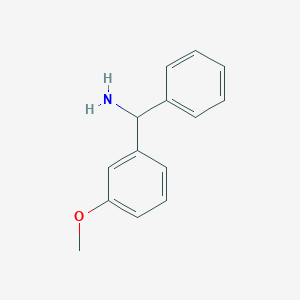
![3,4-Dihydro-2H-pyrano[3,2-b]pyridin-4-ol](/img/structure/B3029695.png)
![Gal|A(1-3)[Neu5Ac|A(2-6)]GlcNAc-|A-pNP](/img/structure/B3029696.png)
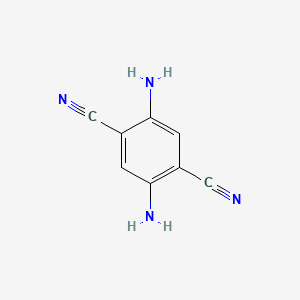
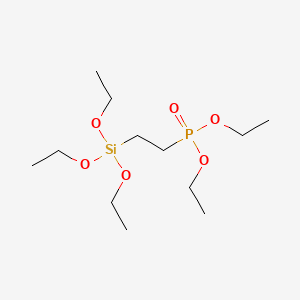

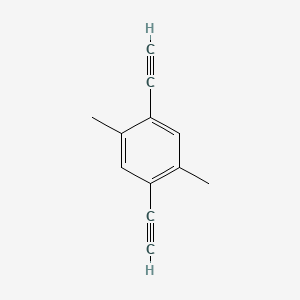
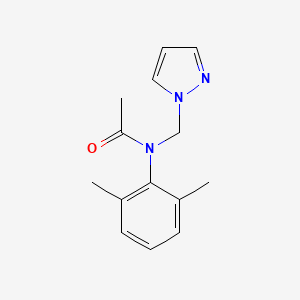
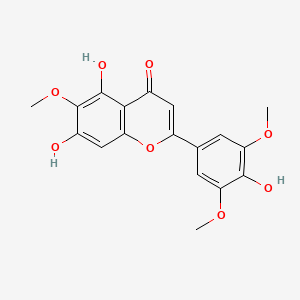


![[6]-Dehydrogingerdione](/img/structure/B3029713.png)

